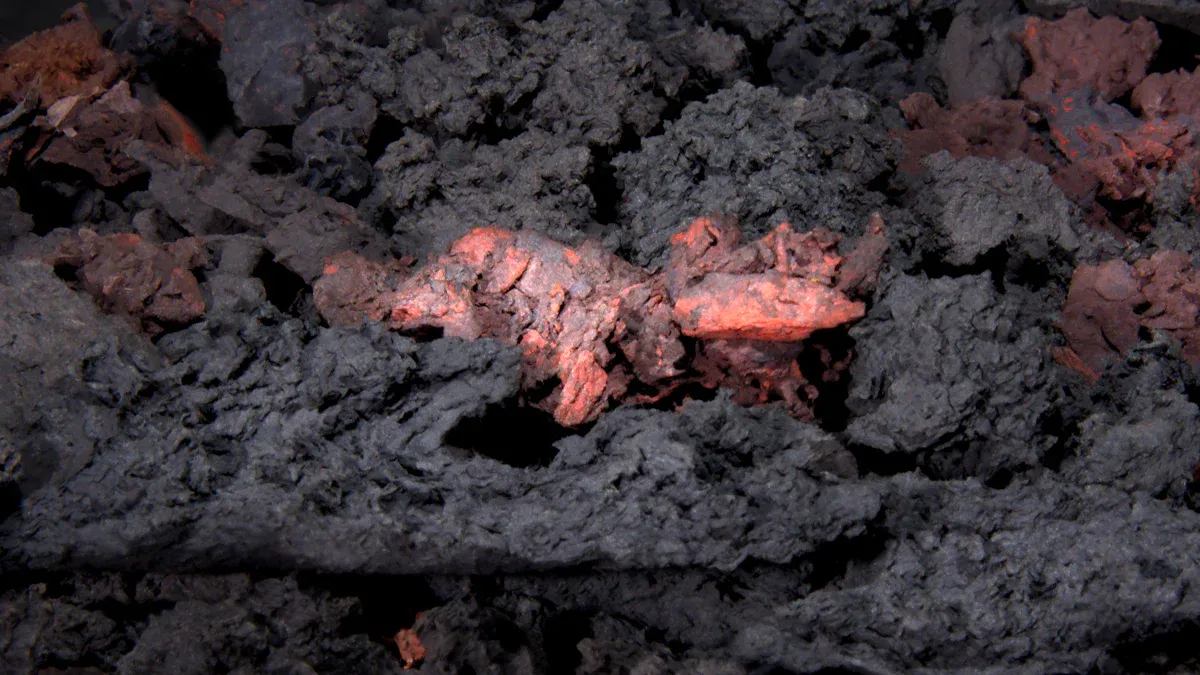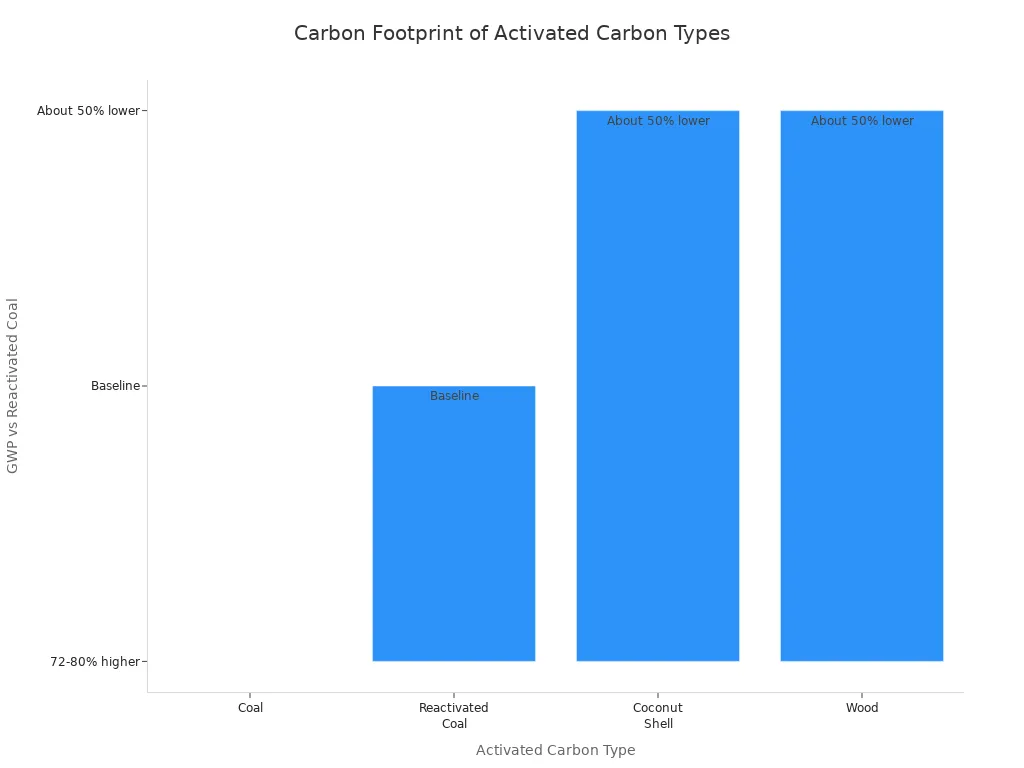
Citric acid charbon actif imprégné has a changed surface. This special surface helps it work better. It can adsorb more pollutants than regular activated carbon. The citric acid makes the surface better at removing metals and organic compounds. Citric acid impregnated activated carbon can target bad stuff more easily. You can use it to get cleaner water and air. This makes it different from other Impregnated Activated Carbon types.
Principaux enseignements
Citric acid impregnated charbon actif has a special surface. This helps it remove bad things from water and air better.
This carbon can catch and take out heavy metals like copper and lead. It also removes organic compounds, so it is great for cleaning.
Adding citric acid makes more active spots on the carbon. This helps the carbon hold more pollutants.
People can use things like coconut shells and food waste to make this carbon. This helps the environment by using less harmful materials.
Citric acid impregnated activated carbon can be used in many ways. It works for water treatment, air cleaning, and in factories.
Vous pouvez clean and use this carbon again. This saves money and makes less waste.
Using this kind of activated carbon can clean better. It also helps make the environment healthier.
Always test the carbon for your needs. It may not work for every pollutant.
Citric Acid Impregnated Activated Carbon Overview
Definition and Core Concept
Citric acid impregnated charbon actif is a special kind of activated carbon. It goes through a process that changes its surface. Citric acid is added to the surface during this process. This makes the material work better for cleaning water and air. The surface now has more places to trap unwanted things. Because of this, it can remove metals and organic matter more easily.
When citric acid is used, more active spots form on the carbon. These spots help the carbon grab and hold pollutants. The surface attracts copper ions and other harmful particles. You can use this activated carbon in many places that need strong cleaning.
Key Features
Citric acid impregnated activated carbon is different because of its special features. The surface has more functional groups from the citric acid. These groups help the carbon catch and hold more pollutants.
Here are some important features to remember:
Enhanced Adsorption: The changed surface helps the carbon absorb water and other things better. It works well for removing metals or organic compounds.
Improved Water Absorption and Sorptivity: Tests show this carbon absorbs more water and has higher sorptivity than regular activated carbon. You can see this in the table below:
Series
Water Absorption
Sorptivity
Reference
Lowest
Lowest
Citric Acid + Lime Milk
Highest
Higher than others
Citric Acid + Glasswater
Similar to others
Varies with w/c ratio
Higher w/c
Higher absorption
Lower sorptivity
Targeted Pollutant Removal: This carbon can remove certain pollutants like copper ions and organic matter. The changed surface helps it focus on these targets.
Sustainable Modification: Sometimes, waste materials are used in the process. This makes the carbon better for the environment.
Applications polyvalentes: You can use this carbon for traitement de l'eau, air cleaning, and in factories. The changed surface makes it useful in many ways.
Tip: For better cleaning, pick activated carbon with citric acid surface modification. The extra functional groups help a lot.
Surface Modification Process
Citric Acid Treatment Steps
Concentration and Application
You begin by soaking activated carbon in citric acid solution. Most people use a 0.3 M citric acid concentration for this. This amount changes the carbon’s surface in big ways. Using this level, the surface area of the carbon drops by about 34% to 38%. The smallest pores get smaller, but bigger pores get larger. This change helps the carbon trap certain pollutants better.
Les BET surface area goes down by about 14% after treatment.
The BJH pore volume also gets smaller, but the carbon can now hold bigger molecules.
The new surface has more active spots for catching pollutants.
Materials Used
You need activated carbon and citric acid for this process. You can use either granular or powdered activated carbon. Citric acid is the main chemical for changing the surface. Sometimes, other chemicals are added to help, but citric acid is most important. You soak the carbon in the citric acid, then heat it to help the change happen. After that, you wash and dry the carbon to finish the process.
Sustainable Sources
Citric acid impregnated activated carbon can be made from waste. Many companies use old food, like expired soda, white rice, or damaged buckwheat. These waste items have organic carbon, which works well for this process. You treat these materials with chemicals like potassium carbonate or orthophosphoric acid to make them better at adsorbing. This way, you recycle waste and help the environment.
Choosing sustainable sources helps the planet. The table below shows how different sources affect the environment:
Type de charbon actif | Impact sur l'environnement | Carbon Footprint Comparison |
|---|---|---|
Coal | Highest in 10 out of 12 categories | 72-80% higher GWP than reactivated coal |
Reactivated Coal | Lowest in 3 categories | 72-80% lower GWP when biogenic emissions included |
Coconut Shell | Lower than coal | About 50% lower GWP than reactivated coal |
Wood | Lower than coal | About 50% lower GWP than reactivated coal |

Biomass sources are easier to find and better for the earth.
Activated carbon from biomass has less impact on the environment.
Using renewable resources saves money and helps nature.
Tip: To lower your carbon footprint, choose activated carbon made from coconut shells or wood. These sources work well for citric acid surface modification and help keep the planet clean.
How Citric Acid Impregnated Activated Carbon Works
Mécanisme d'adsorption
Chemical Property Changes
When you treat charbon actif with citric acid, the surface changes a lot. The surface gets new chemical groups called carboxyl groups. These groups help the carbon pull in and hold pollutants. Adsorption happens mostly by chemisorption, which means strong chemical bonds form. More than one layer of molecules can stick to the surface. This process is fast and uses strong forces between molecules. The pseudo second-order kinetic model shows the adsorption is quick and strong.
Enhanced Pollutant Removal
Citric acid modification gives activated carbon a higher adsorption capacity. It can remove more pollutants, especially metals like copper, from water or air. The new surface lets the carbon grab copper ions much better. The carbon can hold up to 14.92 mg Cu/g, which is 140% more than before. Carboxyl groups make the bond with copper ions stronger. Even though the surface area drops by 34%, the carbon still holds more pollutants. The process is a little slower, but it removes metals and organic matter better.
Role of Citric Acid
Citric acid is very important in this process. It adds special groups to the activated carbon’s surface. These groups help the carbon catch heavy metals and organic compounds. You can see this when removing metals like chromium, copper, nickel, and zinc. At low pH, citric acid helps remove up to 100% of chromium and zinc, 98% of nickel, and 88% of copper. Lead removal also gets better, reaching 95% after 11 days. If you set the pH to 3, you can remove 100% of lead in just one day. Nickel and zinc removals are fast too, with 70% and 80% gone in two hours.
Citric acid helps you target certain pollutants.
The change makes charbon actif better for cleaning water and air.
You get better results for heavy metals and organic matter.
Note: Using citric acid to change the surface gives you a strong way to clean up pollutants. This process helps your activated carbon work harder and adsorb more.
Comparison with Regular Activated Carbon
Surface Chemistry Differences
Citric acid impregnated activated carbon has a changed surface. Regular activated carbon does not have these changes. Scientists use tests like FT-IR and TPD to check the surface. The citric acid version has more oxygen groups. These groups help the surface react with acids and bases. There are more spots for reactions to happen. This helps the carbon grab metals and pollutants better. Regular activated carbon has fewer special groups. Its surface is more neutral and less active. Lab tests show these differences clearly.
Efficacité de l'adsorption
Citric acid impregnated activated carbon cleans better. The new surface groups hold metals and organic matter tightly. You get stronger bonds with copper and lead ions. Regular activated carbon can clean, but not as much. The citric acid surface boosts adsorption power. You can remove more pollutants with less carbon. This means water and air get cleaner faster.
Tip: Use citric acid impregnated activated carbon for tough jobs. It works better for heavy metals and strong organic compounds.
Application Performance
Activated carbon is used in water filters and air purifiers. Factories also use it. Citric acid impregnated activated carbon gives better results. The surface targets certain pollutants. Copper ions are removed from water quickly. Organic matter is also cleaned better. Regular activated carbon is good for basic cleaning. It cannot match the citric acid version for tough tasks. The special surface saves time and protects health and the environment.
Citric acid impregnated activated carbon: Best for targeted cleaning and high efficiency.
Regular activated carbon: Good for general cleaning and wide use.
Note: Pick the right activated carbon for your needs. The surface makes a big difference.
Main Applications

Traitement de l'eau
Citric acid impregnated activated carbon is used to clean water. It helps take out metals and organic matter from water. The special surface grabs copper ions better than regular carbon. Many water plants use this carbon to remove heavy metals. It works well when you need to get rid of copper ions. This carbon also helps make sugar solutions clear. You can use it to clean drinking water or water for food making. The process makes water safer and clearer for people to use.
Tip: Try citric acid impregnated activated carbon if you want cleaner water. It helps remove more copper and gives better results.
Purification de l'air
This carbon is also good for cleaning air. You can put it in air filters to catch bad gases and tiny particles. The special surface helps trap metals and organic stuff from the air. It works well for grabbing copper ions in air cleaning systems. Many factories use this carbon to keep air safe for workers. You can also find it in home air purifiers. The carbon helps remove smells and harmful chemicals from the air. Using this carbon helps protect your health.
Homes and factories get cleaner air with this carbon.
It helps take out metals and organic matter from the air.
Industrial and Environmental Uses
Many industries use citric acid impregnated activated carbon. The food industry uses it to clean food and water used in making products. This carbon helps companies follow safety rules. Factories use it to remove copper ions when working with metals. The food industry also uses it to make sugar solutions look better. Food products can taste and look better with this carbon.
Copper Ion Removal
Many factories need to remove copper ions from water. This carbon is very good at grabbing copper ions. It helps keep wastewater safe for the environment. Factories use it to follow rules about heavy metals. You get better copper removal where strict cleaning is needed.
Domaine d'application | Benefit of Citric Acid Carbon | Copper Adsorption Efficiency |
|---|---|---|
Water Treatment Plants | Cleaner water | Haut |
Metal Processing | Safer waste | Very High |
Industrie alimentaire | Safe food production | Haut |
Organic Matter Adsorption
This carbon also helps remove organic matter. The food industry needs clean water to make safe products. Using this carbon gives better cleaning results. It traps organic compounds and keeps food safe. Factories see strong results in cleaning water and air. The carbon helps meet health rules and makes products better.
Note: You can use citric acid impregnated activated carbon in many ways. It gives better cleaning, copper removal, and organic matter removal in water, air, and food factories.
Benefits and Considerations
Avantages
There are many good things about using citric acid impregnated activated carbon. The special surface helps you clean water and air better. You can remove heavy metals like copper, lead, and zinc. It also helps get rid of organic matter easily. This makes cleaning stronger and more dependable.
Better Adsorption: The extra functional groups help trap more bad stuff.
Eco-Friendly Choice: Using carbon from waste or plants helps the earth.
Versatile Uses: You can use this carbon in filters, purifiers, and factories.
Cost Savings: You might need less carbon, so you save money.
💡 Conseil : Try citric acid impregnated activated carbon for better cleaning. It often works better than regular carbon.
Limites
There are some things to watch out for. Citric acid impregnated activated carbon does not work for everything. Sometimes, the surface area gets smaller after treatment. This can change how much it can hold.
Reduced Surface Area: The surface can shrink and hold fewer small things.
Slower Adsorption for Some Pollutants: It may work slower for some metals or organic stuff.
Higher Cost for Special Treatment: Making this carbon can cost more money.
Not for All Pollutants: Some chemicals do not stick well to the new surface.
Limitation | What It Means for You |
|---|---|
Smaller surface area | May hold fewer small molecules |
Slower for some pollutants | Takes longer to clean |
Higher production cost | May cost more to buy |
Not universal | May not work for all chemicals |
⚠️ Remarque : Always test the carbon with your water or air problem. This helps you know if it will work for you.
Regeneration and Safety
You can use citric acid impregnated activated carbon again. You clean it by washing or heating. This is called regeneration. Regeneration saves money and cuts down on waste.
Easy to Regenerate: You can wash or heat the carbon to reuse it.
Safe to Handle: The carbon is safe if you follow safety rules. Wear gloves and a mask when handling a lot.
Proper Disposal: If the carbon is full of metals, throw it away safely. Follow local rules for hazardous waste.
🛡️ Safety Tip: Always wear protective gear when you touch used activated carbon. Used carbon can hold dangerous stuff.
Citric acid impregnated activated carbon cleans well and helps the planet. Just remember its limits and always follow safety steps.
Future Trends in Activated Carbon
Innovations in Surface Modification
There are many new ideas for activated carbon. Scientists are working on better ways to change its surface. These changes help remove more pollutants from water and air. One big trend is using safe chemicals like citric acid. This makes the product safer and good for the environment.
Researchers are testing plant acids and enzymes now. These can add more special groups to the carbon. You might see activated carbon with extra carboxyl or amino groups soon. These groups help target things like dyes, pesticides, or viruses. Some labs use nanotechnology to make the surface more active. This lets the carbon clean faster and hold more pollutants.
Here are some cool new things you might see:
Bio-based Modifiers: Fruit acids, plant extracts, or food waste can change the carbon surface.
Multi-functional Carbon: Some activated carbon can remove metals, organic matter, and germs at once.
Smart Carbon: Some new carbons change their surface if you change pH or temperature. You can control what the carbon removes.
💡 Conseil : Look for new products that use green chemistry. These help you clean better and protect the earth.
Impact sur l'environnement
You help the environment when you pick the right activated carbon. The future is about making carbon from renewable sources. You can choose carbon made from coconut shells, wood, or recycled food waste. These choices lower the carbon footprint and save resources.
Factories now use less energy to make activated carbon. Some factories clean and reuse old carbon. This cuts down on waste and pollution. Using carbon from plants or recycled stuff helps lower greenhouse gases.
Here is a table that shows how different sources affect the environment:
Carbon Source | Renewable? | Carbon Footprint | Waste Reduction |
|---|---|---|---|
Coal | Non | Haut | Faible |
Coconut Shell | Oui | Faible | Haut |
Wood | Oui | Faible | Haut |
Food Waste | Oui | Very Low | Very High |
🌱 Remarque : Picking activated carbon from renewable sources helps fight climate change. It also supports a cleaner world.
More companies will use eco-friendly ways to make and use activated carbon. These changes help you get better cleaning and protect the earth for the future.
Citric acid impregnated activated carbon is different because of its special surface. This surface helps take out more metals and organic matter from water and air. You can use it for cleaning water and air in many places. Picking this carbon helps protect nature and saves resources. The citric acid change makes activated carbon stronger and better for the earth. People will use it more as they find new ways to fight pollution.
